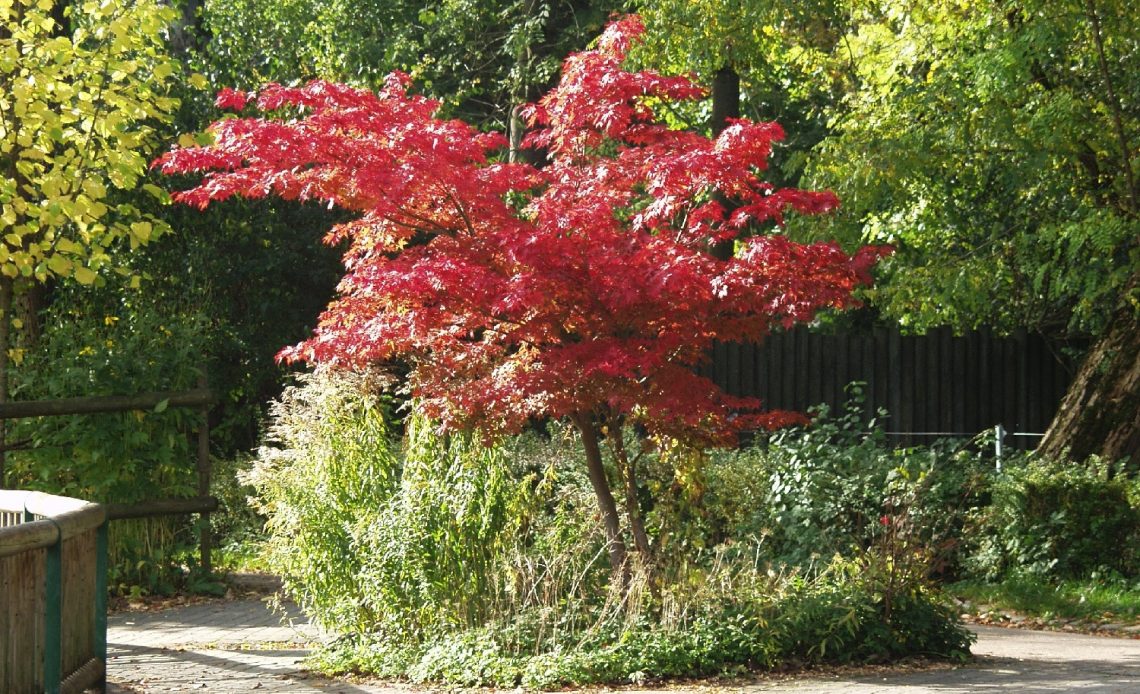

We’re here to help! Wild Yards is a completely free website that is 100% dedicated to helping you create a wildlife-friendly, sustainable yard. Read more
WildYards is reader-supported. When you buy a product through a link on our site, we may earn a comission. Every product is independently selected by our (obsessive) editors and our reviews are unbiased and objective. Read more about our mission or our privacy policy.
If your yard stays in the shade because it’s surrounded by woods, but you haven’t got any trees on your own property, you may be wondering what your options are. Many trees require full sun to grow, but trees are a vital part of any wild yard landscape. Large trees, like oaks and elms, grow slowly in low light. But there are a number of small trees that grow in the shade that you can use to dress up your backyard.
Japanese Red Maple trees are small and bushy with sprawling limbs and vibrant foliage. Crape Myrtles, Dogwoods, Redbuds, Japanese Snowbells, and Saucer Magnolias produce gorgeous flowers that add a splash of color to a shady landscape. And Oakleaf Holly and Mulberry trees produce berries that will attract birds, squirrels, and other wildlife to your yard.
12 Small Shade-tolerant Trees for Your Backyard
If you only have room for a container garden, there are a number of dwarf trees that can be grown in pots. Even if your tiny backyard is situated in full sun, there’s a tree to suit your needs. But which small trees can be grown in full shade? Here are 12 of our favorites to help get you started!
Japanese Red Maple (zones 5 through 8)
Japanese Red Maples grow beautifully in the shade, where they reach mature heights of 15 to 25 feet. These trees take on a rounded shape, their scarlet to maroon red leaves cascading far around them, giving them a wide dripline.
Though the Japanese Red Maple is slow to medium growing, when it does mature, its branches span out about as far as the tree is tall. This provides plenty of shelter for squirrels, chipmunks, and songbirds, who love to nibble on this maple’s seeds, leaves, and flower buds. The Japanese Red Maple is suited to all soil types. For an interesting take on this timeless classic, look for ‘Orangeola’ and ‘Red Dragon’ varieties.
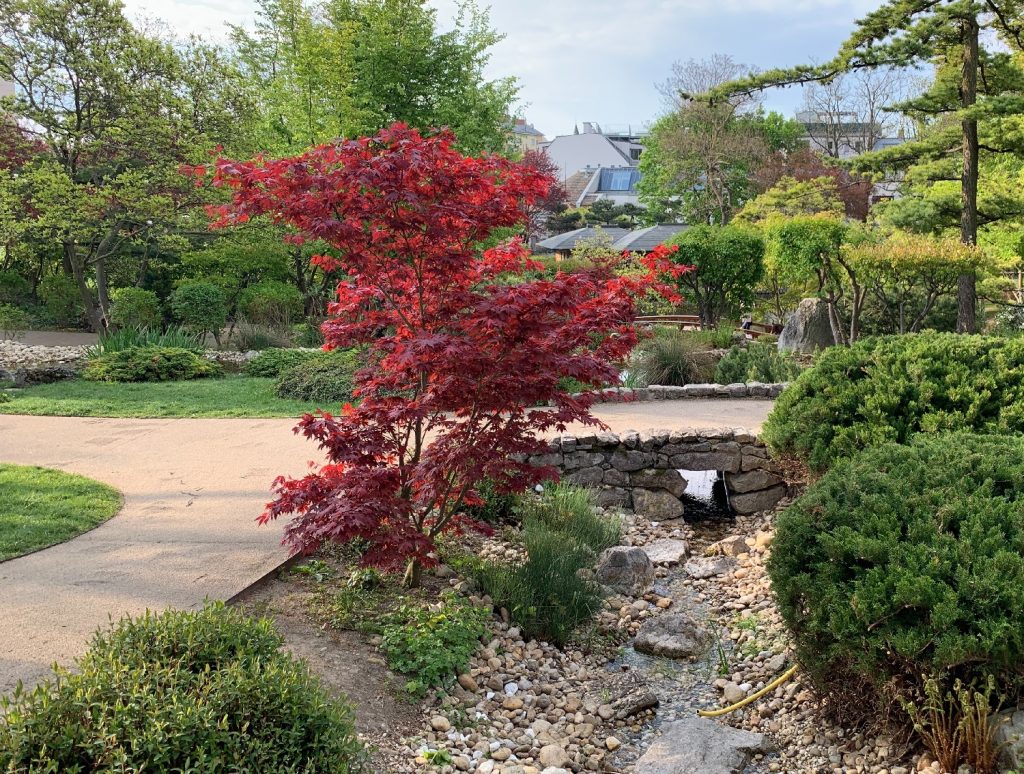
Oakleaf Holly (zones 6 through 9)
These cone-shaped trees grow vertically, maxing out at 20 feet tall and at least 8 feet wide. Their shiny, dark green, spiked leaves, typical of most holly varieties, make this an interesting addition to any landscape. This is an evergreen shade-tolerant tree, so it retains its foliage during the winter when the leaves take on a yellow-green appearance. In spring, when new leaves form, they emerge a rich purple-green color.
Oakleaf Holly looks right at home planted on opposite sides of an exterior doorway or along the side wall of a garage. They can be trimmed to maintain a stylish manicured look, or allowed to grow wild. These are fast-growing trees that need plenty of water to thrive. But, because it’s disease and insect resistant, it’s pretty low-maintenance otherwise.
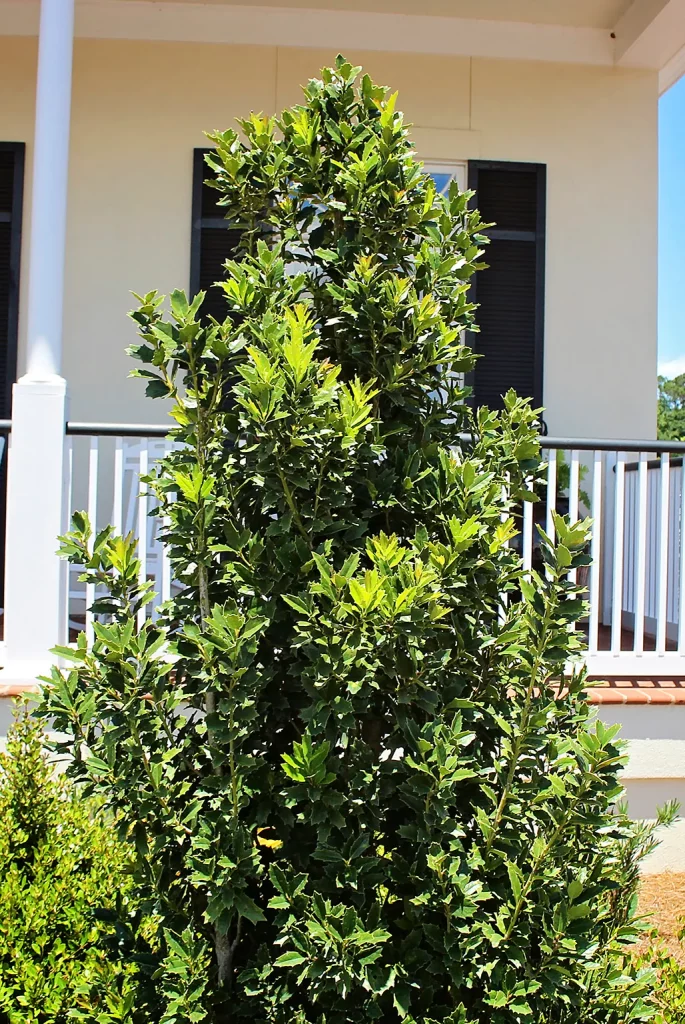
Portuguese Laurel (zones 4 through 9)
Native to Portugal, this shade-loving little tree is also called the Portugal Plum Tree. It’s a flowering ornamental that’s commonly used as a privacy hedge because it branches out and gets thick when pruned back. You can grow your Portugal Laurel trees in a variety of soils. Once established, these drought-tolerant trees can grow up to 30 feet tall by 15 feet wide.
The Portugal Laurel is fast-growing, creating an abundance of dark green, oval leaves with shiny surfaces and smooth edges. In the spring and summer months, this tree produces long stalks covered in sweet-smelling white flowers that bees, butterflies, and other pollinators love to peruse. Once the flowers fade, the tree produces red berries that songbirds enjoy foraging on.
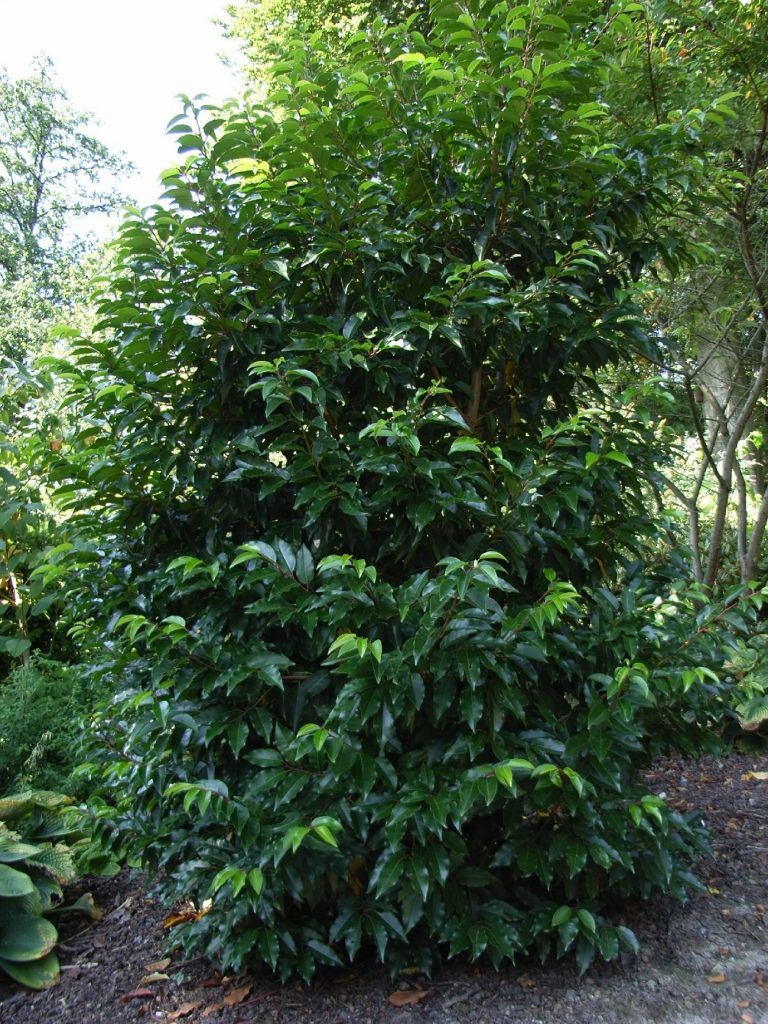
Eastern Redbud (zones 4 through 9)
If you have a shady yard, you can’t go without a Redbud tree. Eastern Redbuds produce violet-pink blossoms on bare branches in early to mid-spring before they leaf out. The flowers are a hit with pollinators, especially bees, but they can be gathered and included in salads, too. This tree’s distinctive heart-shaped foliage emerges one leaf at a time, adding small increments to the branches, giving them a segmented look.
These trees reach 20 to 30 feet tall and 25 to 35 feet wide. Eastern Redbuds grow at a medium rate, and they can tolerate a wide range of soil types, from clay to sand, from alkaline to acidic. Once established, they’re drought-resistant, but they do need to be watered regularly when they’re young.
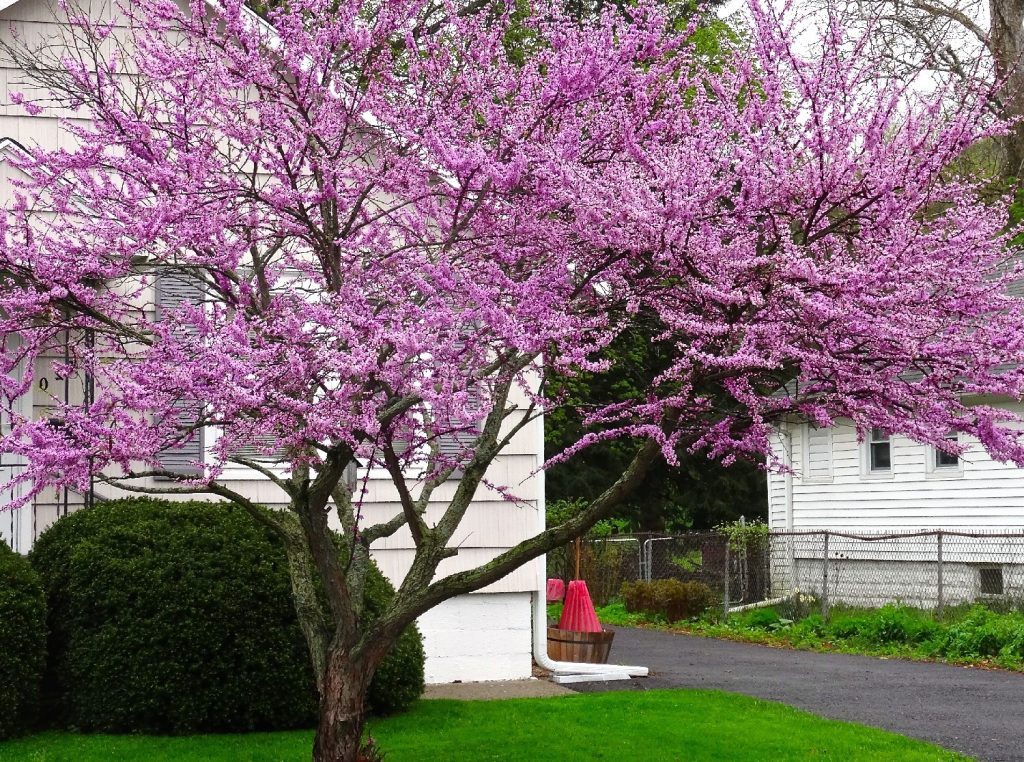
Crape Myrtle (zones 6 through 9)
One major pitfall to living in a wooded area is the deer. Majestic as they are, they can obliterate expensive landscaping in no time. Fortunately, the Crape Myrtle is relatively deer-resistant, as they just don’t care for its tough branches and leathery foliage. The Crape Myrtle, sometimes called “the lilac of the South”, is an incredibly low-maintenance tree that performs best in well-drained soil (regardless of pH). Fast-growing, it reaches 20 to 30 feet tall and just as wide in 5 to 10 years.
Crape Myrtles bloom from May to June, producing tissue-paper-like flower petals in varying shades of pink, purple, red, and white. When not in bloom, the Crape Myrtle’s interesting bark takes the stage. Gray-brown sheets of thin bark peel away, revealing the tree’s pale tan trunk underneath. Crape myrtles provide much-needed shade to many animals during the summer months. Songbirds and bees are especially fond of the Crape Myrtle.
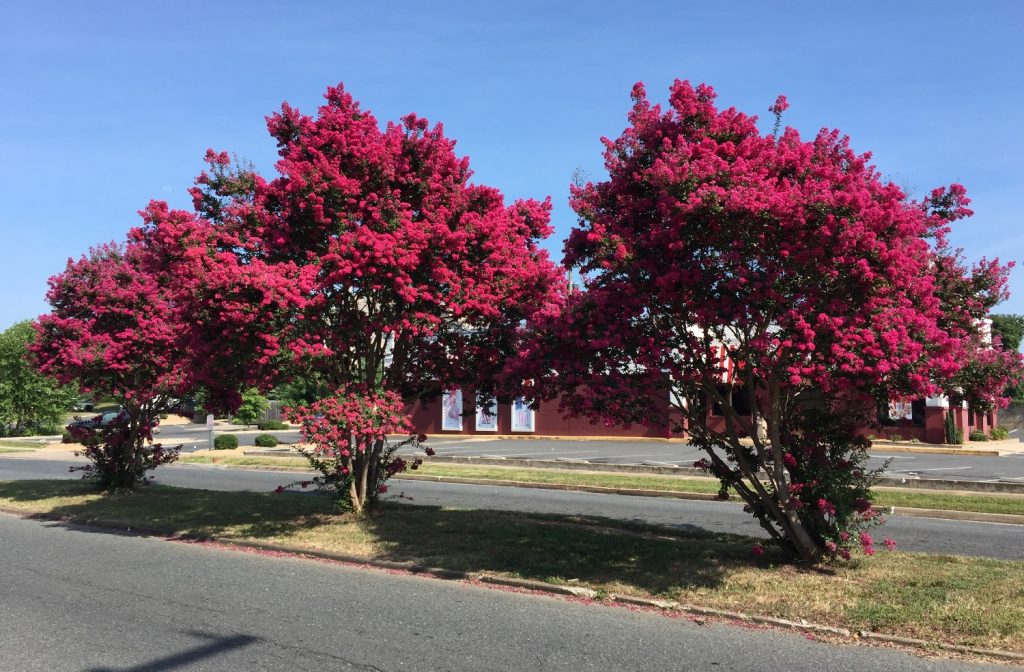
Flowering Dogwood (zones 5 through 9)
Dogwood trees have seen a boost in popularity in recent years, so there are several gorgeous cultivars to choose from. The classic Flowering Dogwood matures in about 10 years and grows to be around 25 feet tall. It has a medium growth rate, an attractive rounded canopy, and can be grown in any soil as long as it drains well.
Flowering Dogwood trees bloom in spring when their iconic 4-petal flowers emerge in shades of white, pink, and yellow. In fall, their green leaves turn purple-red until they fall off and the tree goes dormant for the winter. Dogwood trees of all varieties attract bobwhite quail and wild turkeys as well as many songbirds, who eat the fruit and collect the tree’s small twigs to build nests. Other animals, like squirrels, rabbits, deer, bears, and beavers also feed on this tree’s limbs and foliage.
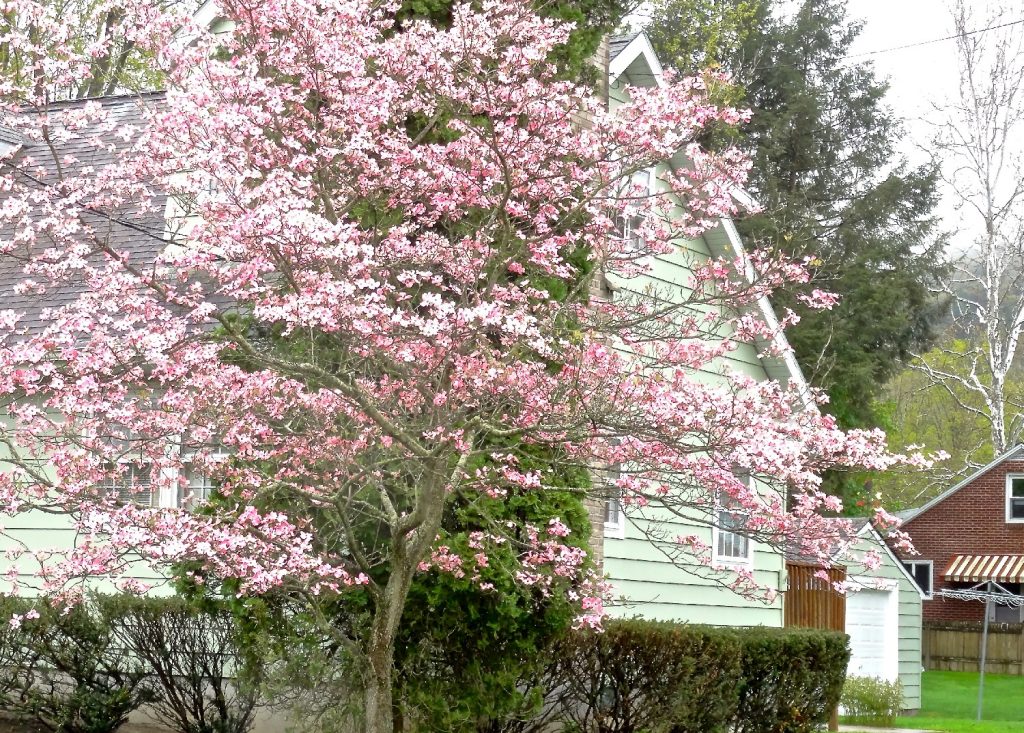
Mulberry (zones 6 through 8)
If you’re looking for a small shade-tolerant fruit tree, give the Mulberry tree a shot. This tree produces hundreds of deliciously sweet berries in midsummer, perfect for making jams, jellies, and pie fillings. The berries also attract a ton of wildlife, including birds, squirrels, and deer. The only downside is that the berries can make a sticky, slippery mess on the ground around them if they’re not eaten in time. So if you’d rather not deal with that, look for non-fruiting Mulberry trees instead.
Even though Mulberry trees can reach heights of 80 feet, they tend to stay much shorter than that when planted in the shade. Grown as an understory, they tend to only reach 25 to 30 feet tall. Plus, these trees can stand up to regular trimming, so if you’d like to keep yours shorn back to accommodate your backyard space, feel free to do so. Grow your Mulberry trees in well-drained soil with a pH of 5.5 to 7.
Red Buckeye (zones 6 through 9)
The Red Buckeye, or Red Horse Chestnut, grows up to 20 feet tall and 30 feet wide. This deciduous tree produces an abundance of foliage. Its many oval-shaped, serrated leaves create a shady canopy for songbirds and squirrels to enjoy. In spring, the trees flower, creating a showy display of dark pink blossoms. The Red Buckeye’s fantastic blooms make it one of the most beautiful ornamental landscape trees in America.
The Red Buckeye gets its name from its seeds, which resemble the eye of a deer. Though these seeds are toxic to pets, squirrels sometimes enjoy nibbling on them. These trees also attract hummingbirds and butterflies when they’re in bloom. Red Buckeyes are easy to care for and can be grown at any pH, but they prefer moist, well-drained soil.
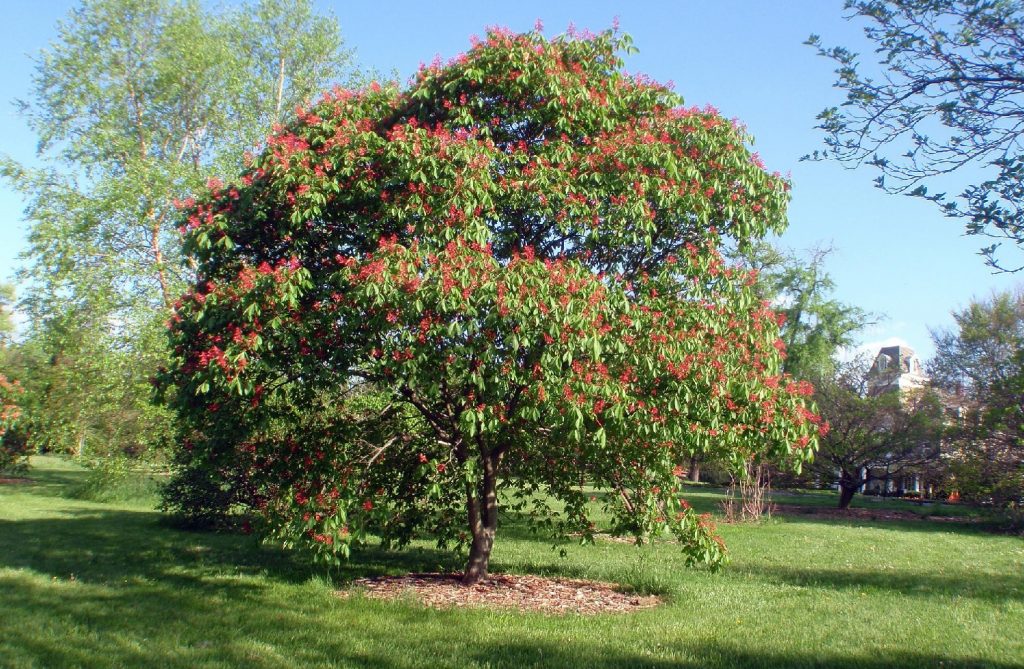
Saucer Magnolia (zones 4 through 9)
Saucer Magnolias are shrub trees with branches growing outwards and upwards from fairly low on the trunk. This makes them an ideal place for many birds to build their nests. This tree is a hybrid relative of the Southern Magnolia. But unlike that tree, which can grow up to 80 feet tall, the Saucer Magnolia only reaches maximum heights of 30 feet. This plant grows at a moderate pace and develops a rounded canopy.
These small, shade-loving trees produce dozens of goblet-shaped flowers in shades of white, pink, and purple every spring. Deer, rabbits, and other wildlife like to nibble on the baby buds. This tree grows well in all soil types, especially rich soils with plenty of organic matter that can stay moist, but not soggy. The Saucer Magnolia is uniquely suited to growing in tight spaces, so you can plant yours near your home’s foundation without causing any problems down the road.
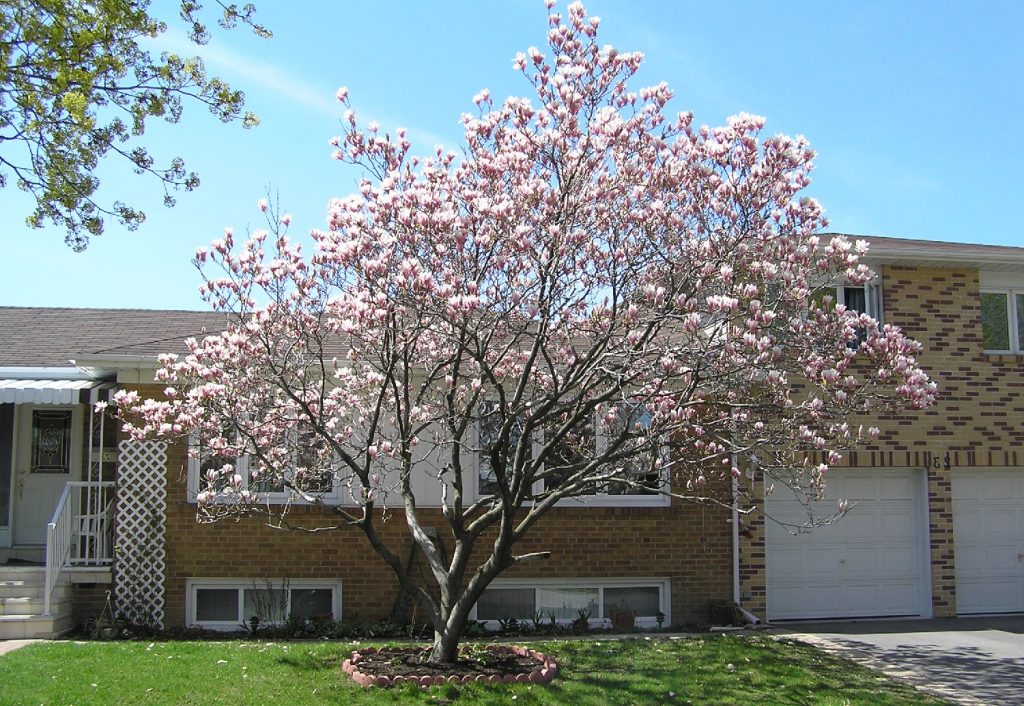
Japanese Snowbell (zones 5 through 8)
This tree’s delicate appearance belies its sturdy, tenacious nature. The Japanese Snowbell grows slowly, but it thrives in the shade where it eventually reaches 30 feet tall. The small, oval-shaped leaves are a crisp shade of green like a Granny Smith apple, and they line the slender branches of the tree to give your garden an ethereal quality.
Japanese Snowbells have lovely foliage, but this tree is best known for its flowers. White bell-shaped blossoms grow in clusters during the midsummer months. The flowers’ sweet fragrance attracts bees, butterflies, and many other pollinators. Japanese Snowbell trees grow best when planted in acidic soil that is well-drained but can be kept moist. They grow to be 30 feet tall by 25 feet wide but can be trimmed back if desired.
White Birch (zones 2 through 6)
While the White Birch tree can reach heights of 40 feet, it can be trimmed back as it grows to stay smaller. This tree’s vibrant lime green foliage eventually branches out to around 30 feet, giving it a large spread. But, pretty as they are, this tree’s leaves aren’t the main attraction. It’s the bark that makes it such a showy ornamental. The outer layer of the White Birch’s bark sheds as the trunk grows, making it a focal point in any garden.
The White Birch is a stickler about its soil requirements. It must be planted in sandy soil that drains well. Additionally, this tree does not like competition from neighboring ground covers, like ivy or mint, so plant your White Birch where it can grow alone.
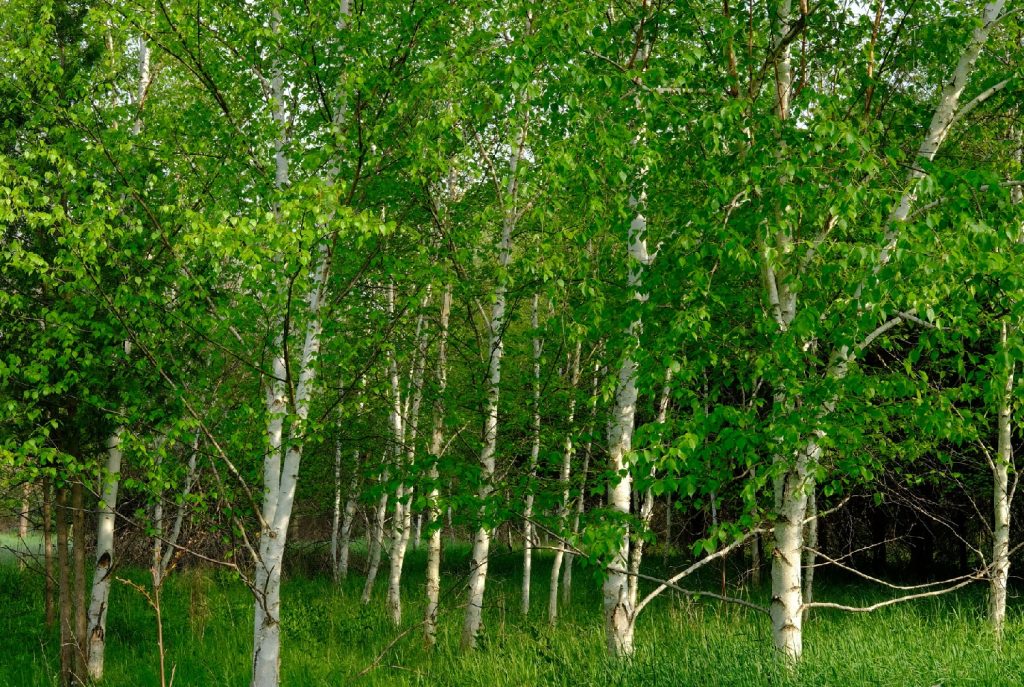
American Bladdernut (zones 4 through 8)
If you need a small shade-loving tree that isn’t too picky about drainage, the American Bladdernut is right for you. This tree can tolerate soils that don’t drain too well. In fact, it’s commonly found in bottomlands, where the nutrient-rich soil stays wet for months at a time. It’s frequently used to dress up backyard water features, from lily ponds to decorative waterfalls.
The American Bladdernut tops out at 15 feet and grows just as wide, giving it a rounded, uniform appearance that accents any landscape. Once established, it grows runners that produce new plants several feet away from the mother tree. Fast-growing for a shade-tolerant tree, the American Bladdernut produces bell-shaped white flowers in the spring, much like the Japanese Snowbell’s blooms. The seeds of this plant are stored in round air-filled pods (or bladders) until they’re released.
Growing trees in the shade: a few tips
When planting shade-tolerant trees, be sure to follow the tree’s specific planting guidelines. While all of the trees mentioned here grow well in shady conditions, they don’t share the same soil requirements. Evaluate your soil ahead of time by checking the pH, testing the nutrients, and understanding its draining capacity. Be sure to amend the soil appropriately before planting your trees.
Additionally, while these trees can handle growing as an understory layer below taller shade trees, they don’t like to be smothered. They need dappled sunlight for photosynthesis. So be sure to keep low branches from taller neighboring trees trimmed back to ensure there’s enough room for all of them to grow.
Living in low-light conditions doesn’t mean you can’t grow trees. With the help of these 12 small trees that grow in shade, you can dress up your garden and support your local wildlife all at the same time.

I live in Scottsdale AZ and I am looking for a tree that will grow in the shade. I want to start the trees while the evergreens above them are still alive. The evergreens may not survive much longer so I want to get a start on the trees that will replace them. I like the Japanese Red Maple, if they mature and have no shade on day, will they still thrive.
Thanks, Gary
Hi Gary, thanks for your question! I’m sorry to say it, but Japanese red maples suffer when planted in full sunlight. That said, they may still be worth considering if you plant them alongside other trees that are more tolerant of full sun. Jacaranda trees, for instance, are hardy to full sunlight, and they grow very quickly. These trees produce gorgeous purple flowers and can grow up to 10′ their first year. Jacaranda trees are also tolerant of partial sunlight, so they will survive in the shade of your pre-existing evergreens. Planting jacaranda trees now would give the trees a chance to start growing and provide your Japanese red maples with some some shade as they grow, even if/when your evergreens die out. I hope this helps you, and good luck gardening!